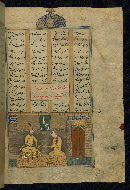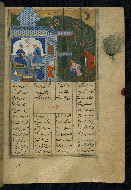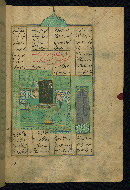Home > Digitized Walters Manuscripts
This document is a tranformation of a TEI P5 XML manuscript description incorporating images. If you have trouble reading special or non-Latin characters on this page, please make sure you have appropriate Unicode fonts installed and an up-to-date web browser.
Walters Ms. W.608, Five poems (quintet)
Browse images (Browse images in a new window) | TEI in XML format
W.608
Five poems (quintet)
Vernacular: خمسه نظامى
Authority name: Niẓāmī Ganjavī, 1140 or 41-1202 or 3
Supplied name: Ilyās ibn Yūsuf Niẓāmī Ganjavī
Name, in vernacular: الياس بن يوسف نظامى گنجوى
Note: Author dates preferred by cataloger: d. 605 AH / 1209 CE
This is an illuminated and illustrated copy of the Khamsah (quintet) by Niẓāmī Ganjavī (d. 605 AH / 1209 CE), completed by Ḥabīb Allāh ibn ʿAlī ibn Ḥusām in Safavid Iran in Rabīʿ II 971 AH / 1563 CE. Illuminated titlepieces introduce the five poems, and there are thirty illustrations, the majority of which are attributable to thirteenth century AH / nineteenth CE Qajar Iran. Ownership notes and seals indicating the provenance of this manuscript are found throughout the codex (fols. 1a, 2a, 153a, 177a, 233a, 349a, and 351a). The binding is not original to the manuscript.
Mid Rabīʿ II 971 AH / 1563 CE
Iran
As-written name: Ḥabīb Allāh ibn ʿAlī ibn Ḥusām
Name, in vernacular: حبيب الله بن علي بن حسام
Book
Literary -- Poetry
The primary language in this manuscript is Persian. The secondary language of this manuscript is Arabic.
- Transliteration: tammat al-kitāb bi-ʿawn al-Malik al-Wahhāb bi-tārīkh muntaṣaf shahr Rabīʿ al-thānī 971 bi-khaṭṭ aqall al-anām Ḥabīb Allāh ibn ʿAlī ibn Ḥusām /1/
- Comment: In Arabic, giving name of scribe and date of copying
Paper
Laid paper
Foliation: 351
Catchwords: Written obliquely on versos
17.0 cm wide by 24.0 cm high
11.5 cm wide by 17.0 cm high
- Columns: 4
- Ruled lines: 21
- Framing lines in blue, black, and gold
- Title: Khamsah-i Niẓāmī
- Author: Niẓāmī Ganjavī, 1140 or 41-1202 or 3
- Scribe: Ḥabīb Allāh ibn ʿAlī ibn Ḥusām
- Incipit: بسم الله الرحمن الرحيم هست كليد در كنج حكيم...
- Text note: Main text preceded by a biographical note on Niẓāmī (fol. 2a); consists of Makhzan al-asrār (fols. 2b-30b), Khusraw va Shīrīn (fols. 31b-108b), Laylá va Majnūn (fols. 109b-161b), Haft paykar (fols. 162b-224b), and Iskandarnāmah (fols. 225b-351a); text out of order in a number of places
- Hand note: Written in black nastaʿlīq script; chapter/section headings in red ink
- Decoration note: Thirty illustrations; titlepieces (fols. 2b, 31b, 109b, 162b, 225b, and 307b); framing lines in blue, black, and gold
fol. 2b:
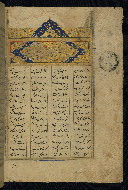
- Title: Illuminated incipit with titlepiece
- Form: Incipit; titlepiece
- Text: Makhzan al-asrār
- Label: This incipit page has an illuminated titlepiece introducing the first poem of the Khamsah, Makhzan al-asrār. It is inscribed in white on a gold ground with polychrome floral decoration.
fol. 31b:
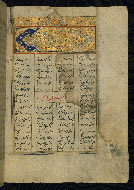
- Title: Illuminated incipit with titlepiece
- Form: Incipit; titlepiece
- Text: Khusraw va Shīrīn
- Label: This incipit page has an illuminated titlepiece introducing the second poem of the Khamsah, Khusraw va Shīrīn, which is inscribed in white on a gold ground with polychrome floral decoration.
fol. 45b:
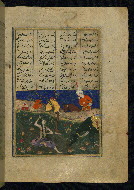
- Title: Khusraw watching Shīrīn bathing
- Form: Illustration
- Text: Khusraw va Shīrīn
- Comment:
While the composition of this miniature dates to 10th century AH / 16th CE, elements of the illustration were repainted in the 13th century AH / 19th CE.
fol. 51b:
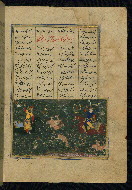
- Title: Khusraw and Shīrīn hunting
- Form: Illustration
- Text: Khusraw va Shīrīn
- Comment:
While the composition of this miniature dates to 10th century AH / 16th CE, elements of the illustration were repainted in the 13th century AH / 19th CE.
fol. 54a:
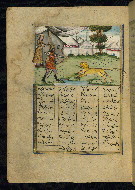
- Title: Khusraw kills a lion outside Shīrīn's tent
- Form: Illustration
- Text: Khusraw va Shīrīn
- Comment:
While the composition of this miniature dates to 10th century AH / 16th CE, elements of the illustration were repainted in the 13th century AH / 19th CE.
fol. 69b:
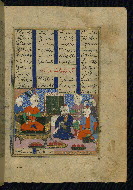
- Title: Farhād brought before the throne of Khusraw
- Form: Illustration
- Text: Khusraw va Shīrīn
- Comment:
While the composition of this miniature dates to 10th century AH / 16th CE, elements of the illustration were repainted in the 13th century AH / 19th CE.
fol. 72b:
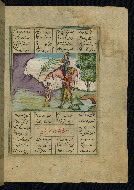
- Title: Farhād carries Shīrīn and her horse
- Form: Illustration
- Text: Khusraw va Shīrīn
- Comment:
This miniature dates to the 13th century AH / 19th CE.
fol. 81b:
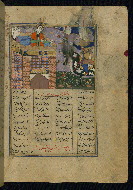
- Title: Khusraw arriving at Shīrīn's palace
- Form: Illustration
- Text: Khusraw va Shīrīn
- Comment:
While the composition of this miniature dates to 10th century AH / 16th CE, elements of the illustration were repainted in the 13th century AH / 19th CE.
fol. 96a:
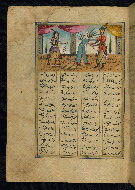
- Title: Khusraw is led by an old woman to Shīrīn
- Form: Illustration
- Text: Khusraw va Shīrīn
- Comment:
While the composition of this miniature dates to 10th century AH / 16th CE, elements of the illustration were repainted in the 13th century AH / 19th CE.
fol. 109b:
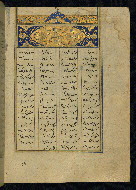
- Title: Incipit with illuminated titlepiece
- Form: Incipit; titlepage
- Text: Laylá va Majnūn
- Label: This incipit page has an illuminated titlepiece introducing the third poem of the Khamsah, Laylá va Majnūn. It is inscribed in white on a gold ground with polychrome floral decoration.
fol. 119a:
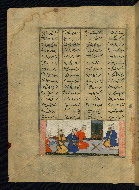
- Title: Laylá and Qays (Majnūn) at school
- Form: Illustration
- Text: Laylá va Majnūn
- Comment:
While the composition of this miniature dates to 10th century AH / 16th CE, elements of the illustration were repainted in the 13th century AH / 19th CE.
fol. 136b:
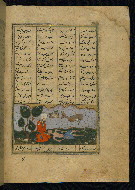
- Title: Majnūn’s father visits his son in the wilderness
- Form: Illustration
- Text: Laylá va Majnūn
- Comment:
While the composition of this miniature dates to 10th century AH / 16th CE, elements of the illustration were repainted in the 13th century AH / 19th CE.
fol. 147b:
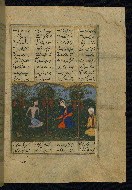
- Title: Laylá visits Majnūn in the wilderness
- Form: Illustration
- Text: Laylá va Majnūn
- Comment:
While the composition of this miniature dates to 10th century AH / 16th CE, elements of the illustration were repainted in the 13th century AH / 19th CE.
fol. 154b:
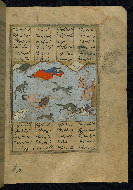
- Title: Laylá and Majnūn faint at the sight of each other
- Form: Illustration
- Text: Laylá va Majnūn
- Comment:
While the composition of this miniature dates to 10th century AH / 16th CE, elements of the illustration were repainted in the 13th century AH / 19th CE.
fol. 162b:
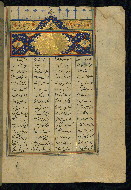
- Title: Incipit with illuminated titlepiece
- Form: Incipit; titlepiece
- Text: Haft paykar
- Label: This incipit page has an illuminated titlepiece introducing the fourth poem of the Khamsah, Haft paykar. It is inscribed in white on a gold ground with polychrome floral decoration.
fol. 173a:
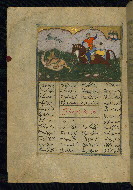
- Title: Bahrām Gūr kills a lion and a wild ass
- Form: Illustration
- Text: Haft paykar
- Comment:
While the composition of this miniature dates to 10th century AH / 16th CE, elements of the illustration were repainted in the 13th century AH / 19th CE.
fol. 174a:
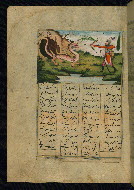
- Title: Bahrām Gūr kills a dragon
- Form: Illustration
- Text: Haft paykar
- Comment:
This miniature dates to the 13th century AH / 19th CE.
fol. 174b:
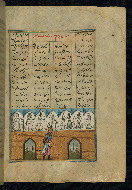
- Title: Bahrām Gūr and portraits of the seven princesses
- Form: Illustration
- Text: Haft paykar
- Label: Bahrām Gūr is depicted with his own portrait and portraits of the seven princesses, inscribed as follows: Azar Sūz, Nasrīn Nūsh, Nāz Parī, Naʿmā Nāz, Fūrak, Daraspī, and Hamāy.
- Comment:
This miniature dates to the 13th century AH / 19th CE.
fol. 178b:
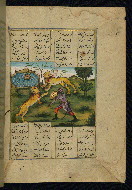
- Title: Bahrām Gūr kills two lions to claim his crown
- Form: Illustration
- Text: Haft paykar
- Comment:
This miniature dates to the 13th century AH / 19th CE.
fol. 181a:
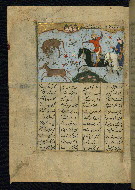
- Title: Bahrām Gūr kills a wild ass before Fitnah
- Form: Illustration
- Text: Haft paykar
- Comment:
While the composition of this miniature dates to 10th century AH / 16th CE, elements of the illustration were repainted in the 13th century AH / 19th CE.
fol. 182b:
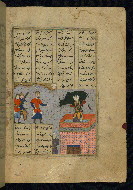
- Title: Fitnah carries a bull on her shoulders in the presence of Bahrām Gūr
- Form: Illustration
- Text: Haft paykar
- Comment:
While the composition of this miniature dates to 10th century AH / 16th CE, elements of the illustration were repainted in the 13th century AH / 19th CE.
fol. 187b:
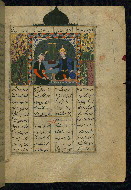
- Title: Bahrām Gūr in the black pavilion
- Form: Illustration
- Text: Haft paykar
- Comment:
While the composition of this miniature dates to 10th century AH / 16th CE, elements of the illustration were repainted in the 13th century AH / 19th CE.
fol. 193b:
fol. 195b:
fol. 204b:
fol. 207b:
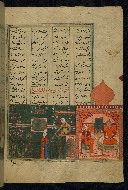
- Title: Bahrām Gūr in the red pavilion
- Form: Illustration
- Text: Haft paykar
- Comment:
While the composition of this miniature dates to 10th century AH / 16th CE, elements of the illustration were repainted in the 13th century AH / 19th CE.
fol. 208a:
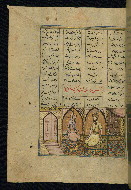
- Title: Bahrām Gūr in the sandalwood pavilion
- Form: Illustration
- Text: Haft paykar
- Comment:
This miniature dates to the 13th century AH / 19th CE.
fol. 208b:
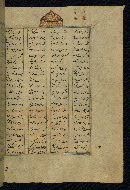
- Title: Dome of the sandalwood pavilion
- Form: Illustration
- Text: Haft paykar
- Comment:
This miniature dates to the 13th century AH / 19th CE.
fol. 213a:
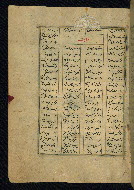
- Title: Dome of the white pavilion
- Form: Illustration
- Text: Haft paykar
- Comment:
This miniature dates to the 13th century AH / 19th CE.
fol. 213b:
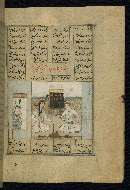
- Title: Bahrām Gūr in the white pavilion
- Form: Illustration
- Text: Haft paykar
- Comment:
While the composition of this miniature dates to 10th century AH / 16th CE, elements of the illustration were repainted in the 13th century AH / 19th CE.
fol. 225b:
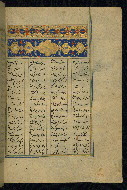
- Title: Incipit with illuminated titlepiece
- Form: Incipit; titlepiece
- Text: Sharafnāmah
- Label: This incipit page has an illuminated titlepiece introducing the Sharafnāmah, the first part of the fifth poem of the Khamsah, Iskandarnāmah. It is inscribed in white on a gold ground with polychrome floral decoration.
fol. 241a:
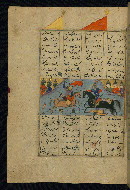
- Title: Alexander the Great kills an Ethiopian warrior
- Form: Illustration
- Text: Sharafnāmah
- Comment:
While the composition of this miniature dates to 10th century AH / 16th CE, elements of the illustration were repainted in the 13th century AH / 19th CE.
fol. 243a:
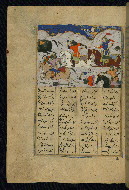
- Title: The army of Alexander the Great pursues the Ethiopians
- Form: Illustration
- Text: Sharafnāmah
- Comment:
While the composition of this miniature dates to 10th century AH / 16th CE, elements of the illustration were repainted in the 13th century AH / 19th CE.
fol. 254a:
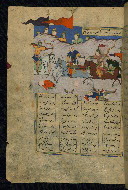
- Title: Alexander the Great defeats the army of the Persian king, Darius
- Form: Illustration
- Text: Sharafnāmah
- Comment:
While the composition of this miniature dates to 10th century AH / 16th CE, elements of the illustration were repainted in the 13th century AH / 19th CE.
fol. 269a:
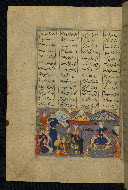
- Title: Alexander the Great in Nushābah’s pavilion in Bardaʿ
- Form: Illustration
- Text: Sharafnāmah
- Comment:
While the composition of this miniature dates to 10th century AH / 16th CE, elements of the illustration were repainted in the 13th century AH / 19th CE.
fol. 287a:
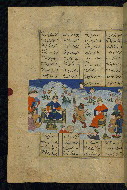
- Title: Alexander the Great entertained at the court of the king of China
- Form: Illustration
- Text: Sharafnāmah
- Comment:
While the composition of this miniature dates to 10th century AH / 16th CE, elements of the illustration were repainted in the 13th century AH / 19th CE.
fol. 298b:
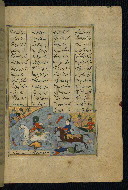
- Title: Alexander the Great lassos a Russian warrior
- Form: Illustration
- Text: Sharafnāmah
- Comment:
While the composition of this miniature dates to 10th century AH / 16th CE, elements of the illustration were repainted in the 13th century AH / 19th CE.
fol. 307b:
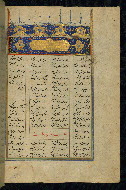
- Title: Incipit with illuminated titlepiece
- Form: Incipit; titlepiece
- Text: Iqbālnāmah
- Label: This incipit page has an illuminated titlepiece introducing the Iqbālnāmah, the second part of the fifth poem of the Khamsah, Iskandarnāmah. It is inscribed in white on a gold ground with polychrome floral decoration.
- Comment:
This miniature dates to the 13th century AH / 19th CE.
The binding is not original.
Brown leather with blind-stamped oval central medallion and pendants (no flap)
Ownership note: Bāqī Pāshā (fol. 1a)
Ownership note with seal: ʿAlī Rizā ibn Muṣṭafá, 1180 AH / 1766-7 CE (fol. 2a)
Seal impression: ʿAlī Mawlā ʿAlī (fols. 153a, 177a, 233a, and 351a)
Ownership note: Ṣāḥibī umm [the mother of] Mīrzā Ibrāhīm (fol. 351b)
Seal impression: Shāh Vardī Ghulām Shāh Mardān (fol. 349a)
Walters Art Museum, 1931, by Henry Walters bequest
Storey, C. A. Persian Literature: A Bio-Bibliographical Survey, Vol. 2. (London: Luzac, 1927- ), 438-495.
Principal cataloger: Gacek, Adam
Catalogers: Landau, Amy; Smith, Sita
Editor: Bockrath, Diane
Conservators: Jewell, Stephanie; Quandt, Abigail
Contributors: Barrera, Christina; Emery, Doug; Herbert, Lynley; Noel, William; Simpson, Shreve; Tabritha, Ariel; Toth, Michael B.; Valle, Chiara
The Walters Art Museum
Licensed for use under Creative Commons Attribution-NonCommercial-ShareAlike 3.0 Unported Access Rights, http://creativecommons.org/licenses/by-nc-sa/3.0/legalcode. It is requested that copies of any published articles based on the information in this data set be sent to the curator of manuscripts, The Walters Art Museum, 600 North Charles Street, Baltimore MD 21201.
